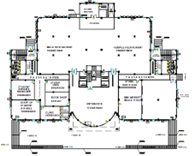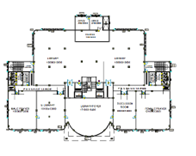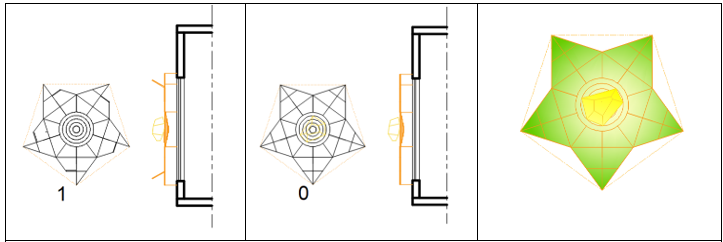Biomimetic Facades: Enhancing Energy Efficiency of Buildings through the Luban Capsule Approach
- Mohamed Alnejem
- Maliha Taghibour
- Ghada Rehan
- -866
- May 21, 2024
- Geology
Biomimetic Facades: Enhancing Energy Efficiency of Buildings through the Luban Capsule Approach
Mohamed Alnejem, Maliha Taghibour, Ghada Rehan
Interior Design Department, Oman College for Management and Technology
DOI: https://doi.org/10.51244/IJRSI.2024.1104063
Received: 16 April 2024; Accepted: 16 April 2024; Published: 21 May 2024
ABSTRACT
The effective use of sustainable renewable energy sources is emphasized heavily in the vision for Oman’s energy industry in 2040 as a crucial tactic in reaching the objective of net-zero buildings. This calls for immediate action to reduce greenhouse gas emissions, especially by improving the efficiency of building facades in metropolitan settings. Biomimicry is a potentially effective approach that utilizes natural phenomena as a source of inspiration to develop novel techniques that mimic diverse creatures, their behaviors, and ecosystems.
The goal of this article is to investigate the use of biomimicry in building facades, with an emphasis on improving facade thermal performance in order to reduce energy consumption. It explores the development and application of the Luban capsule, an adaptive biomimetic element, as a workable way to improve buildings’ energy efficiency, especially in warm areas. The study emphasizes two key points: a theoretical review of biomimicry methodologies and a critical evaluation of specific case studies that are well-known for their application of adaptive facades designed to mitigate solar heat gain.
The Luban capsule, which has Omani roots, was transformed into a biomimetic element by reinterpreting the five leaves, ten stamens, and five calyxes of the Luban flower to create capsule elements with matching number configurations (5, 10, 5). The Luban capsule was then applied to the service buildings on the campus of the Oman College of Management & Technology (OCMT), adjusting their facades in response to the sun’s position along two axes: behavioral aspects (which mimic the Luban flower’s opening and closing mechanism) and organic form (which incorporates the Luban flower’s natural shape) across facades with various elements, orientations, and functionalities.
The study concludes with a framework that aims to minimize the need for artificial lighting, lessen dependency on air conditioning, and mitigate glare in diffused light. These projects play a crucial role in implementing sustainable building practices that are in line with Oman’s long-term energy sector vision by reducing building energy consumption and carbon emissions.
Keywords: Sustainability, biomimicry, tangible, facades, Luban capsule.
INTRODUCTION
To avoid the worst consequences of climate change, greenhouse gas emissions (GHG) must be decreased. According to a special assessment released in 2018 by the International Panel on Climate Change, global warming is expected to have a severe impact on future generations if it exceeds 1.5 degrees Celsius. This document also includes a chapter on mitigation strategies for keeping warming below 1.5 degrees. Buildings are a crucial part of mitigation methods since they consume a lot of energy. The IPPC study emphasized the critical role that renewable energy sources play in meeting the 1.5°C target. As energy demand falls, emissions reduction measures become more adaptable [1]. Human activity demands a huge quantity of energy, and buildings account for almost 19% of global greenhouse gas emissions [2], To reduce building operational energy consumption, it is necessary to increase the thermal performance of building envelopes, particularly facades. Building envelopes have traditionally been viewed as static structures [3]. Recent improvements in building energy efficiency recognize the importance of façade-integrated systems [4], with examples of active and passive façade systems described in [5].
RESEARCH METHODOLOGY
This study seeks to attain this goal by employing theoretical and analytical procedures. It begins with a review of the theoretical framework for biomimicry, concentrating on the approaches, levels, and sublevels of biomimicry to aid in the next step. Following the selection of numerous examples of biomimetic building skins under similar settings, a full investigation will be undertaken on several examples of biomimetic buildings. This analysis will help determine the most effective biomimetic indicators and skin-building factors. The researchers will next suggest a Luban Capsule unit based on native plants in Oman for the OCMT service building facade, as well as analyze and design the facade to get the best possible result.
BIOMIMICRY:
Nature inspires and encourages creativity in all fields of design, planning, and science [1]. The term ‘biomimicry’ refers to mimicking and emulating nature in order to address human issues. It is derived from the Greek words’ bios (“life”) and mimesis (“to imitate”). A relatively recent field in which nature’s best ideas are studied and applied to address issues. Historically, biomimicry has employed natural elements as units, imitating the proportions of their constituent parts that were represented in classical aesthetics.
Inefficient structures use a lot of energy, materials, and resources, making them increasingly significant. In addition, design techniques are becoming less environmentally friendly [6]. Biomimicry enables sustainable design; it also requires knowing how the philosophy of natural life influences design to tackle specific difficulties. As a result, the building can be tailored to the conditions of its surroundings, including creatures.
The building industry uses at least 40% of worldwide final energy. The building’s skin accounts for around 80% of this quantity, directing heat and cold through the structure. Passive systems are one of the most important worldwide concerns for reaching net-zero carbon emissions in the construction sector by 2050 [1]. Building skins have received a lot of attention around the world due to their thermal performance. Throughout the previous decade, research has concentrated on creating skins, but a comprehensive assessment of findings remains inadequate.
This article aims to employ biomimicry to develop sustainable building coverings that maximize thermal efficiency, reduce energy consumption, and assure user comfort.
APPROACHES FOR BIOMIMICRY
Researchers and designers can approach biomimicry-based design from two separate perspectives. There are two methods to design: “problem-driven inspired design” and “solution-driven biologically inspired design.” [7] A problem-based approach begins with a design problem and progresses to objectives [8]. The solution-based method of design begins with the scientific understanding of biologists and scientists rather than the difficulties that humans face.
Maibritt Pedersen Zari, a professor at Victoria University in Wellington, divided biomimicry into three categories: species, behaviors, and ecosystems [4]. The extent of mimicry at each level is determined by five dimensions, or sublevels. These dimensions include form or appearance, material, construction, procedure, and functionality or capability [9].
- Organism level: Organism-level buildings mirror an organism’s form, material, function, construction, and process, as well as some of its overall features [10].
- Behavior level: At the behavioral level, the design will be influenced by the organism’s behavior, conduct, and interactions with its wider environment, as well as how it lives or reproduces on a regular basis and functions [11].
- Ecosystem level: An ecosystem design depicts both the organism’s immediate environment and its complete ecosystem. To build a sustainable environment, it emphasizes the natural processes and cycles of nature[11].
COOLING CONCEPTS:
Nature-inspired adaptation methods rely on changes in physical properties, behavioral reactions, or cooling processes. Physical qualities that aid limit heat gain include tiny surfaces exposed to sunlight, high density, and a high proportion of internal volume to the surface area. Physical qualities such as spinning, hair, waxy exterior layers, and thick layers improve thermal insulation.
Aside from physical considerations, plants and animals exhibit outstanding behavioral reactions. Some plants, such as ferns, rotate their leaves away from direct sunshine, while some animals, such as lizards, rest in tunnels and dark regions, move quickly, or raise their bodies to avoid direct sunlight. The same approach might be mimicked or imitated for active systems in structures. Mechanical systems put on buildings could rotate, use movable shade devices, and control wind catch. It could potentially become a permanent characteristic, such as erecting underground structures or elevating them over hot ground.
In addition to cooling devices, natural ventilation is another type of adaptation mechanism that uses ground depth, water, or conduction to discharge internal heat. Animals exploited the depths of the soil to stay cool, especially when temperatures were high. This principle is also utilized to design passive cooling systems in architecture, such as underground airflow tunnels.
LUBAN IN OMAN:
Luban tree is one of the elements inscribed in UNESCO list for tangible heritage in Oman, it is one of the rare wild trees and become one of the most important symbols in Oman for since thousands of years, Dhofar governorate in Oman is considered largest major historical areas for Luban production in the world and known as Land of Luban. Luban tree does not need watering and human attention and it is about 3-5m high and becomes able to give after 8-10 years of it is growth, Luban flower consist of (5 leaves, 10 stamens, and 5 calyx) and its opening process have many steps according to its behavior.[12]
This article is concerned with emulating Oman’s native plants (Luban flowers) and understanding their organism and behavior to reduce heat and survive the plants, and then using this knowledge to building façade design.
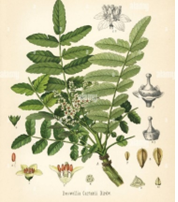 |
| Fig.1: Luban flower |
PREVIOUS CASES
These case studies show the use and effectiveness of the mimicry strategy for a specific organism, behavior of the organism levels in adaptable building envelopes to regulate solar heat gain via the facade and improve the quality of the inside environment.
| Table (1). Case- Study, Service building at OCMT (Plans & Section) | ||
| The Project information | The application in design | The Figures |
| The new Minister of Municipal Affairs & Agriculture building Form.
Architect: Bangkok firm Aesthetics Architecture Location: Qatar The cactus-inspired design. [13]. Inspiration |
– A design that combines the best aspects of biotic adaptation to its surroundings, inspired by cacti [13]. The window sunshades have been designed to open or close in response to temperature, mimicking the evening activity of cactus that performs transpiration at night rather than during the day to retain water. |  |
| Al Bahar Towers
Architect: Aedas Architects. Completed: June 2012, The height: 145-meter towers Site: Abu Dhabi Inspiration |
– For Al Bahar Towers, Aedas Architects designed a double façade system to protect against the intense desert sunshine. In response to movement of the sun, the external façade is kinetically designed to open and close. White butterfly wings have an influence on the design of solar panels. According to Peter Koch, the shutters adapt to changes in temperature and light levels inside the building by opening and closing like butterfly wings. It helps conserve electricity and utilises natural light. | 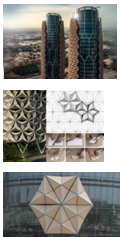 |
| The TIC – Media building
Designed by Enric Ruiz Geli, Location: Cloud 9, Barcelona Based on a network of plant stomas that are supported by inflatable pillows |
It depends on a network of plant stomas that are supported by inflated pillows. A guard cell and an auxiliary cell form each plant stoma. As the plant opens its stomata to control its temperature, the guards open and close the hole by absorbing or releasing water in such a way that they either fill up or drain out like a water balloon. [13] |  |
| Doha Towers
-Architect: Ateliers Jean Nouvel -Client Sheikh Saud bin Muhammed Al Thani Design 2002-2003 -Completed 2012 -Location: The West Bay business district on Corniche Road, Doha, Qatar. -The open and darkening surface pores of the cactus plant serve as inspiration for the facade screen. |
– The curtain wall composed of reflective glass and the dynamic screen are essential components of the Doha Tower’s façade system. The open and darkening surface pores of the cactus plant serve as inspiration for the facade screen, which also considers a reference to the traditional Islamic style known as Mashrabiya.
– Four distinct scales of aluminum “butterflies” make up the screen pattern on the facade. [14]. |
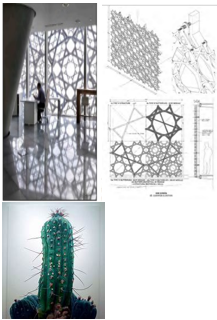 |
| Tricon Corporate Centre
Name: Pakistan. Tricon Corporate Center (office building) – Location: Lahore, Pakistan -The organism and behavior levels of the Oxalis oregana plant |
-The organism and behavior levels of the Oxalis oregana plant were combined to create the skin of the Tricon Corporate Centre.[14]. The Oxalis organa plant can track the amount of sunshine it receives because of its photoreceptors. In just six minutes, the leaf can transform from a horizontal to a vertical angle. [15] |  |
CASE STUDY (SERVICE BUILDING AT OCMT)
Oman college for management and technology (OCMT) located in Muscat, Oman founded in 2004 with 4 programs (interior design, Admin & financial science, computer science and MIS, General foundation), OCMT campus contains three buildings (administration building, academic building, service building).
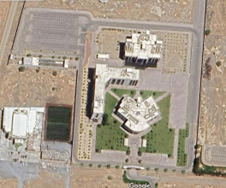 |
 |
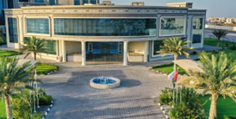 |
| Fig.2: OCMT campus |
The paper shed light on the Service building as a case study as it has various directions, elements and functions. This case study consists of three levels with different spaces in each level, in the ground floor there are (male and female restaurant, entrance, mini market, store, student affair manager, book shop, clinic, student union, kitchen, bathroom), and in the first floor are (library, e-library, male prayer, female prayer, foyer, discussion room, bathroom), and in the second floor are ( multipurpose hall, male activity area, female activity area, bathroom, store), and the main facade is oriented towards south.
 |
| Ground Plan
|
| First Plan
|
| Second Plan
|
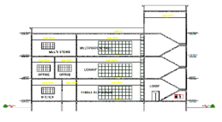 |
| Section C-C |
| Fig (3): Case- Study, Service building at OCMT (Plans & Section) |
SUGGESTED CONCEPT (LUBAN CAPSULE UNIT):
The Luban capsule concept was transformed into a biomimetic element by converting the parts of the Luban flower (5 leaves, 10 stamens, and 5 calyx) to form capsule elements with numbers (5, 10,5).
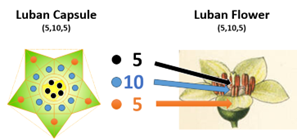 |
| Fig (4): Luban Capsule Concept |
- Elements & Principles:
For understanding Luban capsule unit, the paper explains its elements and principles that will help to understand the concept and its descriptions and properties for 3D design.
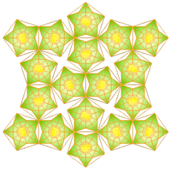 |
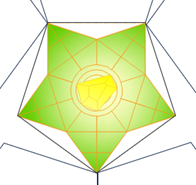 |
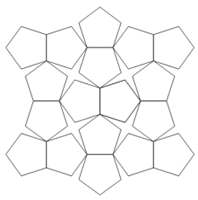 |
| Fig (5): Luban Capsule (Repetition Unit) |
- Elements:
| Table (2): Elements of Luban Capsule Unit Design[16] | |
| Elements | Description |
| Line | The outlines and edges of a unit form is consisting of many lines to form the Luban plan and there is also an ‘implied line’ which is when a line does not really exist but appears to be present. |
| Volume/Shape | The volume is the 3D dimensional space for the unit that consists of many organic shapes in middle and Luban shape in final shape. |
| Space | The space that the unit occupied is 4meter square, which describes the distance, area and volume for the unit. |
| Color | The color of the unit in the material being used. Color is made of three components: Brown (sand), Green (tree) and yellow (Luban). |
| Texture | The texture of the unit is the perceived feel, quality and look of a form’s surface. The texture is smooth in all parts of the unit. |
| Plane | The planes of the unit describe the flat or level surface which gives perspective of the subject, that unit consist of fold and angular planes to help the movement process for all parts. |
| Value | The unit value refers to the relative lightness (yellow, green) and darkness (brown) of an area. this helps to give the illusion of space or depth of an object. |
- Principles:
| Table (3): Principles of Luban Capsule unit Design [16] | |
| Principles | Description |
| Repetition | The repetition of the unit is a repeating visual element for its parts (line, shape, pattern, texture, movement) in obvious way on the facades. |
| Emphasis | Emphasis of the unit is the object, which is usually the subject, that first captures the audience’s attention, the unit emphasis on its center when it closed. |
| Rhythm | The rhythm of the unit is made with the repetition of an elements of unit which creates a pattern (pentagon), that giveback sense of movement or flow of repetition of units. |
| Harmony | Unity or harmony of the unit is created by combining all elements to make a satisfying sense of wholeness in design. |
| Contrast | Contrast is created in the unit by using two or more elements oppose each other. |
| Scale Proportion | The scale of the unit is the appearance of a unit’s size of the facade. Proportion is the relative size of unit objects in relation to each other by focusing on the unit center. |
| Balance | Balance of the unit by equalizing visual elements in the work of art. And in the unit, there are two types of balance: symmetrical and radial. |
- Process:
Luban flower process and behavior in opening and closing is inspired in the mechanism process for the Luban capsule unit during opening and closing that passed in ten steps with different movement for each step in all parts of the unit, we can see that through mapping between section and facade for each step partly.
- Implementation:
The paper discussed the implementation of the Luban capsule unit on the four facades for the service building in OCMT, the result shows that depending on opening and closing process steps must:
- Implement different unit steps during the day date and time.
- Implement different unit final shapes.
- Implement different unit final color scheme.
- Implement different unit steps during the day temperature.
- Implement different unit steps according to space temperature required.
- Implement different unit steps according to facade orientation.
- Implement different unit steps according to plan spaces and functions.
Figure (6): Luban Capsule (Closing process steps)
Figure (7): Luban Capsule (Opening process steps)
Figure (8): Applying Luban Capsule concept on Service building at OCMT (South Facade)
Figure (9): Applying Luban Capsule concept on Service building at OCMT (West Facade)
Figure (10): Applying Luban Capsule concept on Service building at OCMT (East Facade)
CONCLUSION
To avoid the worst consequences of climate change, greenhouse gas emissions (GHG) must be decreased. The first line of defense against climate change is the facade because building envelopes can reduce energy consumption. Biomimicry is an approach that can lead to achieving sustainable development, nevertheless, in order to reduce carbon emissions, it is also necessary to understand how the philosophy of natural life affects design. This allows the structure to be adjusted to the specifics of its environment. The next step in enhancing the façade systems’ performance is to create biomimetic façade design. This is a challenging task, as it calls for expanding biological references to include a wider range of species. Therefore, it is important to pursue the selection and use of a suitable approach for the design of adaptable façades from the first phase of the project. As a case study for the proposed facade, the paper shed light on an existing building in OCMT (Services students building) in Oman. In this work, the paper presented an adaptive facade that reduces solar heat gain and hence the energy consumption of the building. For the design of the facade, we take inspiration from Luban as it is one of the rare wild trees and become one of the most important symbols in Oman for since thousands of years and mimic its abilities of tracking sun path and changing its angle/position accordingly. Luban flower process and behavior in opening and closing is inspired in the mechanism process for the Luban capsule unit during opening and closing that passed in ten steps with different movement for each step in all parts of the unit, that is cleared through mapping between section and facade for each step partly. The design enables shading under both high and low sun angles, without blocking visibility to the outdoor environment and can reduce building services energy consumption. The results showed that in addition to adding extra insulation and acting as a shield against solar radiation, the biomimetic façade had a strong potential to lower operational energy consumption. The interactions between the building and climate change could then be ensured by this proposed unit in a different way. Additionally, the suggested adaptable capsule unit gives occupants choices for customizing their indoor comfort, which raises user satisfaction.
REFERENCES
- Al-Yasiri Q, Szabó M 2022, Energetic and thermal comfort assessment of phase change material passively incorporated building envelope in severe hot Climate: An experimental study. Applied Energy.
- Badarnah L (2017) Form follows environment: biomimetic approaches to building envelope design for environmental adaptation. Buildings 7(2)
- Zari MP, Storey J 2007, An ecosystem-based biomimetic theory for a regenerative built environment. Sustainable building conference.
- Banaei S 2021, TOWARDS A BIOMIMETIC ENVELOPE.
- Staniškis JK, Stasiškienë Z (2003) Cleaner production financing: possibilities and barriers. Clean Technol Environ Policy 5(2):142–147
- El-Mahdy D, Gabr HS 2017, Behavior of natural organisms as a mimicking tool in architecture. International Journal of Design & Nature and Ecodynamics;12(2):24-214.
- Pathak S. 2021, Biomimicry: Innovation Inspired by Nature. William Morrow & Co: London, UK;5.
- Pedersen Zari M 2012, Ecosystem services analysis for the design of regenerative built environments. Building Research & Information;40(1):54-64.
- Othmani NI, Yunos MYM, Ismail NA, Rahman K 2018, Review on biomimicry levels. American Journal of Humanities and Social Sciences Research (AJHSSR) e-ISSN:8-55.
- Amer N 2019, Biomimetic approach in architectural education: case study of ‘biomimicry in architecture course. Ain Shams Engineering Journal;10(3):499-506.
- Zari MP 2007, editor Biomimetic approaches to architectural design for increased sustainability. The SB07 NZ sustainable building conference.
- https://www.omanobserver.om/article/13913/Oman/luban-a-component-that-richens-omans-history.
- Joijode A 2019, Exploring Biotic Approaches in Performance Based Design.
- Sheikh WT, Asghar Q 2019, Adaptive biomimetic facades: Enhancing energy efficiency of highly glazed buildings. Frontiers of Architectural Research;8(3):31-319.
- Atwell BJ, Kriedemann PE, Turnbull CG 1999, Plants in action: adaptation in nature, performance in cultivation: Macmillan Education AU.
- Hameed, Umer. (2022). Elements and principles of art & design. 10.13140/RG.2.2.29128.60161
- ral organisms as a mimicking tool in architecture. International Journal of Design & Nature and Ecodynamics;12(2):24-214.
- Pathak S. 2021, Biomimicry: Innovation Inspired by Nature. William Morrow & Co: London, UK;5.
- Pedersen Zari M 2012, Ecosystem services analysis for the design of regenerative built environments. Building Research & Information;40(1):54-64.
- Othmani NI, Yunos MYM, Ismail NA, Rahman K 2018, Review on biomimicry levels. American Journal of Humanities and Social Sciences Research (AJHSSR) e-ISSN:8-55.
- Amer N 2019, Biomimetic approach in architectural education: case study of ‘biomimicry in architecture course. Ain Shams Engineering Journal;10(3):499-506.
- Zari MP 2007, editor Biomimetic approaches to architectural design for increased sustainability. The SB07 NZ sustainable building conference.
- https://www.omanobserver.om/article/13913/Oman/luban-a-component-that-richens-omans-history.
- Joijode A 2019, Exploring Biotic Approaches in Performance Based Design.
- Sheikh WT, Asghar Q 2019, Adaptive biomimetic facades: Enhancing energy efficiency of highly glazed buildings. Frontiers of Architectural Research;8(3):31-319.
- Atwell BJ, Kriedemann PE, Turnbull CG 1999, Plants in action: adaptation in nature, performance in cultivation: Macmillan Education AU.
- Hameed, Umer. (2022). Elements and principles of art & design. 10.13140/RG.2.2.29128.60161.


